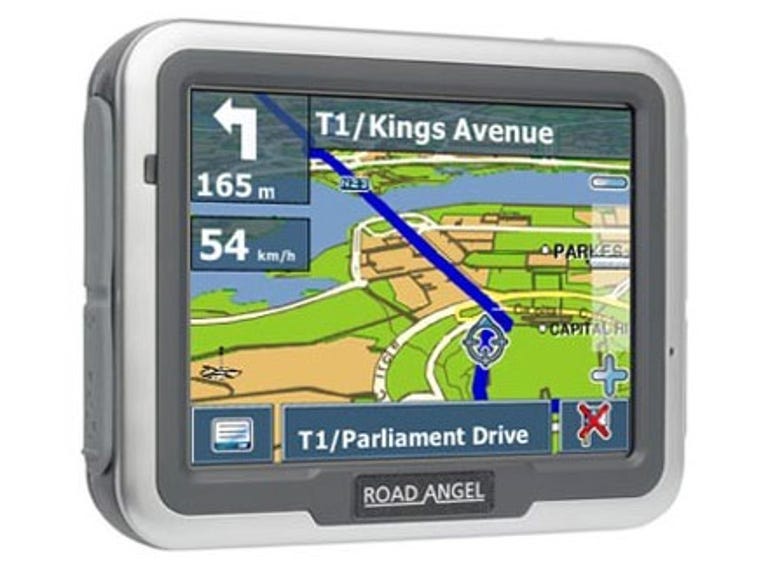 Why You Can Trust CNET
Why You Can Trust CNET Road Angel Navigator 7000 review: Road Angel Navigator 7000
The Navigator 7000 is a fine GPS system with oodles of add-on safety features, but its complexity is also its Achilles heel. Read our Australian review.
Design
The Road Angel Navigator 7000 is, to put it bluntly, a pretty ugly little GPS unit; an unremarkable 95mm by 22mm by 75mm rectangular 160 gram box with a 3.5-inch touchscreen used for all input functions. Rubber covers protect the SD card slot, reset button, USB connector and antenna socket from dust and splashes, although not particularly well. Our test unit came out of the box and from the moment we flipped the flaps up, they refused to slot comfortably back into place. It's not something that largely detracts from the Navigator's core functionality -- it's just a bit of an eyesore.
The Good
The Bad
The Bottom Line
Aside from the core GPS unit itself, the Navigator 7000 also ships with a rather complicated car mounting bracket. This is a multi-part affair that takes some construction before you can stick its sucker cap to your windscreen. To be brutally honest, the Navigator's car mounting kit had us flummoxed for a while, and we began to wonder if we were dealing with an IT variation on the Lemarchand Configuration. It uses a complicated locking procedure for snapping a holding caddy onto the windscreen mounting arm itself, and despite the presence of arrows telling you to push it in certain directions, it took us a solid amount of time to get it all together. When the Road Angel is in the mounting arm, it also charges from it, although with a minimum of fiddling you can also use the USB connector for charging if you've got an in-car USB charging kit.
Features
The Road Angel 7000 has most of the same core features that many GPS vendors offer -- Sensis 2006 mapping data, with the option of other maps via the side-mounted SD card slot, trip planning (including recalculating routes on the fly) and so on. What makes the Road Angel stand out from the pack is the inclusion of lots and lots of optional road data, lumped under the "Road Sense" banner. This is a subscription service -- you get three months free when you buy the Navigator 7000, after which it'll cost you AU$9.99/month to maintain it -- which keeps a constant database of red light cameras, school safety zones and other traffic hazards. When you're entering into a zone of interest, the Road Angel will let you know -- often quite forcefully for a GPS -- so that you can adjust your driving habits -- largely your speed -- to a safe legal limit.
The Navigator brand has had Road Sense installed on plenty of previous models as well, but the other defining feature of the Navigator 7000 is the ability to update the Road Sense data via Bluetooth. This means that you can use your mobile phone to update the 7000 while on the move -- although data rates might make you think twice, depending on your mobile phone plan. As with most other GPS units, the Navigator 7000 also offers voice commands to assist your driving. We're still undecided about whether the decision to continue offering Peter Brock's voice as a safety guide is either an honour for him, or just macabre.
Performance
We tested the Road Angel in an exhaustive fashion, trying it alongside several other GPS models on a drive from Adelaide to Sydney. It was given the chance to run for several hours and in multiple different types of road conditions, which also gave us a good chance to assess its road safety features.
The Road Angel 7000 has plenty of features, and plenty of ways to toggle on or off different alert types depending on user preference. It's great to have this kind of control, but there is a downside, as it makes the Navigator 7000's interface very difficult to learn and requires some solid time tweaking to fit your personal preferences. Unlike competing GPS systems from providers such as TomTom, Navman or Garmin, the Navigator 7000 has a very solid learning curve to it, something that's not entirely desirable in a GPS system. Matters aren't helped by the Navigator 7000's icon-driven interface and somewhat slow response times to screen clicks. While you will eventually learn to remember the icons, this isn't a GPS that you can easily lend to someone else without teaching them its particular interface style.
The Road Angel performed generally well in our testing, routing the same kind of driving pattern as the other units we were concurrently testing -- hardly a surprise, given that they're all based off the same road data. Its GPS lock did go very peculiar on us for one stretch of driving, deciding that we were in fact driving about 100m to the left of our actual current position, although this was driving on a very hot day, where GPS systems often get a bit stymied. For what it's worth, the specifications for the Navigator 7000 give it an upper operating temperature of only 40 degrees, and on longer Australian summer drives it can easily exceed that in an in-car environment.
If you're prepared to learn the interface and can put up with the subscription pricing for the Road Sense application, then the Navigator 7000 comes highly recommended. If you want a simpler device that you can simply plug in and get going with, however, we'd recommend something else.


